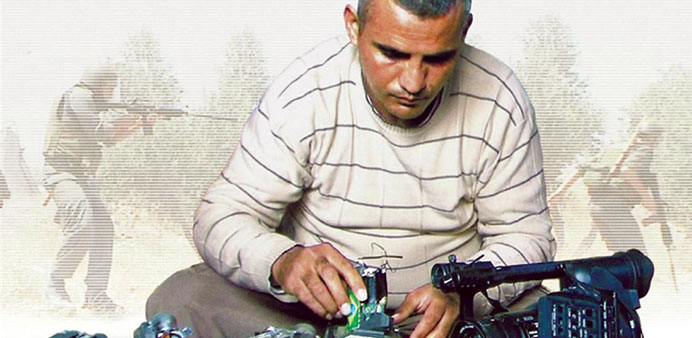By Gautaman Bhaskaran
Everybody loves to go to the movies. Some more than the others. But not many want to see a documentary film, hung up as they are on fictionalised narratives which transport them to a magical world of make-believe. We all want to see a Salman Khan bashing up baddies by their dozens, and when we walk out the theatre, a bit of the actor’s character would have seeped into our psyches. We may not have Khan’s six abs, but we would like to feel our muscles and dream of those ripping ones we saw on the screen.
But there is another kind of movie that fills the screen with images which provoke us to think, even get angry. This is the documentary film, often called the poor cousin of the narrative or feature movie. Documentaries have very little popular appeal, and this is not just in India, but the world over.
Here in India, the medium suffers from a bad reputation created many decades ago by badly produced government-owned Films Division documentaries, which invariably ran before the main films — features of course — were screened in theatres. Time was when people walked into a cinema only in time for the actual movie, skipping the documentary. In present-day Tamil Nadu, for instance, a documentary listing the achievements of the present Chief Minister has probably been made compulsory screening in every theatre. It is just awful. Imagine the plight of a film critic like me: I would have watched the documentary a hundred times by now!
However, some brilliant documentaries are being made in India today, though unfortunately they do not normally find screening outlets. No Inox or IMAX or PVR or any of the leading theatre chains with multiplexes are willing to rent out space for documentaries. And despite the country’s 1,100 television channels, not one is dedicated to this medium. So, these poor cousins have to wait for movie festivals specialising in documentaries with the hope that they would find a berth and an audience.
Interestingly, the International Documentary and Short Film Festival of Kerala, whose sixth edition ended on June 11, attracted 2,000 delegates, and I found the auditoriums more or less packed and often with young men and women. So there is a market for documentaries, which is not really being tapped.
I saw several works at the Festival, and was amazed at the wealth of information they could provide even in this age of Internet.
I did not know that hundreds of men and boys lived off the Yamuna river, diving into it every day to collect coins thrown by travellers — superstitious and religious — as a prayer to fulfil their desires. I did not know that a single man on the banks of the Brahmaputra had created a whole forest by planting trees on a barren expanse for 30 years. I did not know that a species of the horseshoe crab held the potential to reverse diseases like Aids.
Equally alluring were some movies which documented real events, tragic and turbulent. One of them was a Palestine-Israel work, Five Broken Cameras. It was the first ever Palestinian work to have been nominated for the Best Documentary Feature Oscar.
The film, helmed by Palestine’s Emad Burnat and Israel’s Guy Davidi, is a gripping piece of work on the West Asia conflict. It chronicles the frustration and sorrow of Palestinians who have to constantly battle Israeli gunfire and encroachments on the West Bank.
Burnat narrates his personal story — of life in a small village which lives by cultivating olives — with the help of his five cameras, each one broken by Israeli teargas shells or bullets. Indeed, his cameras have at least on two occasions saved his life by acting as a shield between him and the flying piece of fire.
Burnat, a farmer himself, began recording the events around him in his village of Bilin when he got his first camera in 2005 — which coincided with the birth of his youngest son, Gibreel. That year, the villagers, angry over the security fence built by the Israeli army adjacent to their habitation and olive fields, began organising weekly protests, attended by Left-wing Israelis and sympathisers from other countries. In 2007, the Israeli Supreme Court ordered the barrier rerouted, and four years later, villager access to some of the land was restored.
Burnat’s five cameras – which suffered fatal hits during this Palestine-Israel often eyeball to eyeball confrontation – may not have been the only ones to record all these. But his footage accompanied by his own commentary is touching and intimate.
Davidi, a movie director, helped Burnat to edit and compress images captured over five years into a tight documentary. The two have been careful not to let go some great moments – such as the encounters between the demonstrators and Israeli soldiers that often led to ugly situations. Injuries and deaths.
Interestingly, Burnat’s camera also freezes instants which conveyed that the soldiers
were, above all, human, and that they could understand the tragic plight of a people without a nation.
In the final analysis, as the New York Times review said: “This is not to say that the political crisis that unites and separates them is likely to be resolved any time soon, but rather that, even in the midst of that crisis, it is more than just politics that needs to be seen and understood.”
Five Broken Cameras does precisely that by taking us far beyond politics and statecraft, gently reminding us, at the same time, about the immense power of a documentary to touch us.
(Gautaman Bhaskaran has been watching documentaries and festivals celebrating them for many years, and may be e-mailed at [email protected])

Five Broken Cameras: The inside view of the Israeli-Palestinian conflict.


